Feature
The 10 largest tram networks in the world
From quaint historic trams of Europe to cutting-edge driverless modern light rail projects, what are the largest tram networks in the world? Cat Vitale finds out.

Credit:
Light rail transit (LRT) is a form of urban rail public transportation based on electrically powered light rail vehicles (LRV) that operate in a right-of-way system, with substantial potential to reduce greenhouse gas emissions across the transport sector.
Depending on the circumstances, LRT systems can serve a variety of functions. In smaller and medium-sized towns, they serve as the foundation of the public transportation system, while in larger cities, they serve as supplemental lines to the metro.
Melbourne takes the top place in our list – the Australian city with the largest tram network in the world, covering 250km – but it is the only system in the Asia Pacific region to feature on the list of the 10 largest tram networks.
Research from the UITP, demonstrates that as of 2021, there were 403 cities worldwide with at least one operational LRT system, spanning a global operation of over 16,000km of active LRT lines. Additionally, since 2015, the global length of LRT infrastructure has increased by 1% every year on average.
Europe, perhaps unsurprisingly, is the continent with the greatest concentration of tram networks compared to all other regions.
According to UITP data, Europe manages to occupy 58% of the world's total LRT network, with 16,000km of track across the continent, accounting for 75% of all passenger ridership.
The tram 'renaissance', as quoted by UITP is set to spread across major parts of the world, with a host of countries redeveloping infrastructure and investing in future light rail projects.
So, here are the top 10 largest tram networks in the world.
10. Lodz, Poland: 145km
The Lodz tram network, which commenced operation in 1898, features 24 tramlines with a total length of 124.1km (77 miles) and represents the second-largest rail network in Poland.
According to MPK Lodz, the network was founded by an agreement made between the Magistrate of Lodz and a group of business owners about the terms of building and operating a tram network in Lodz.
The Lodz Electric Railway Consortium was subsequently formed as a result, and in 1898 the official opening took place, with a total route length of 2.8km.
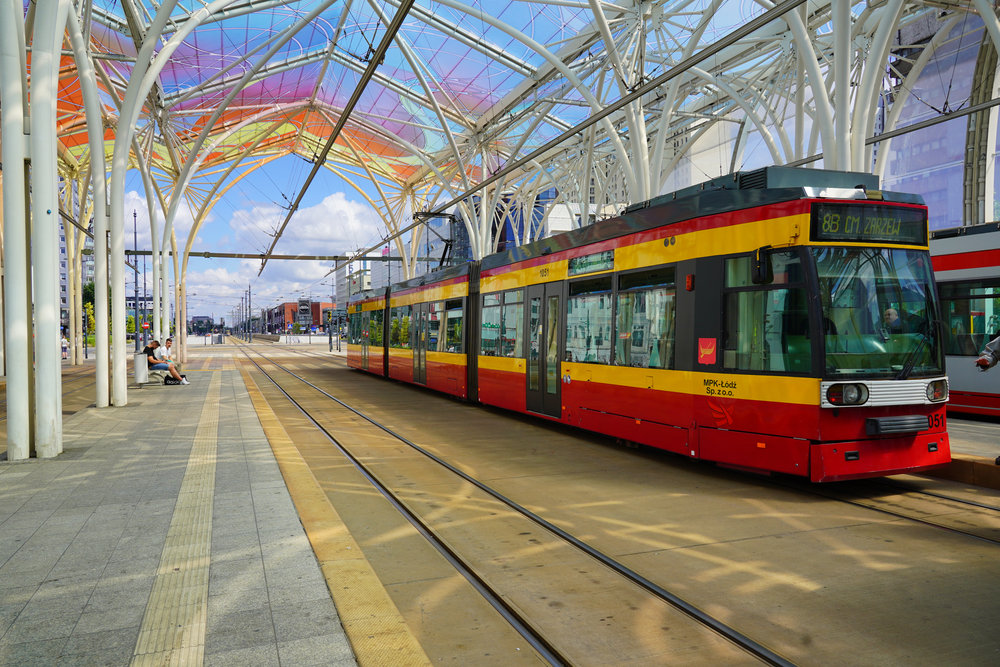
Piotrkowska Centrum, the central tram station in Lodz, Poland. Credit: Mariola Anna/Shutterstock
Recently, however, MPK Lodz says that there has been a decline of the city and suburban tram lines in the city since the late 1970s, due to both economic factors and changes in the city's infrastructure.
The main trams seen across the city today feature a deep red and yellow, chosen by the operator, MPK Lodz.
9. Dallas, US: 149.9km
The Dallas tram network (Dallas Area Rapid Transit- DART), which started operation in June 1996, covers 149.9km (93 miles).
According to reports from UITP, Dallas features the only LRT system across North America which extends to up to almost 150km.
In 2022, the DART system had a ridership of over 18 million passengers and approximately 55,600 per weekday in Q1 2023.
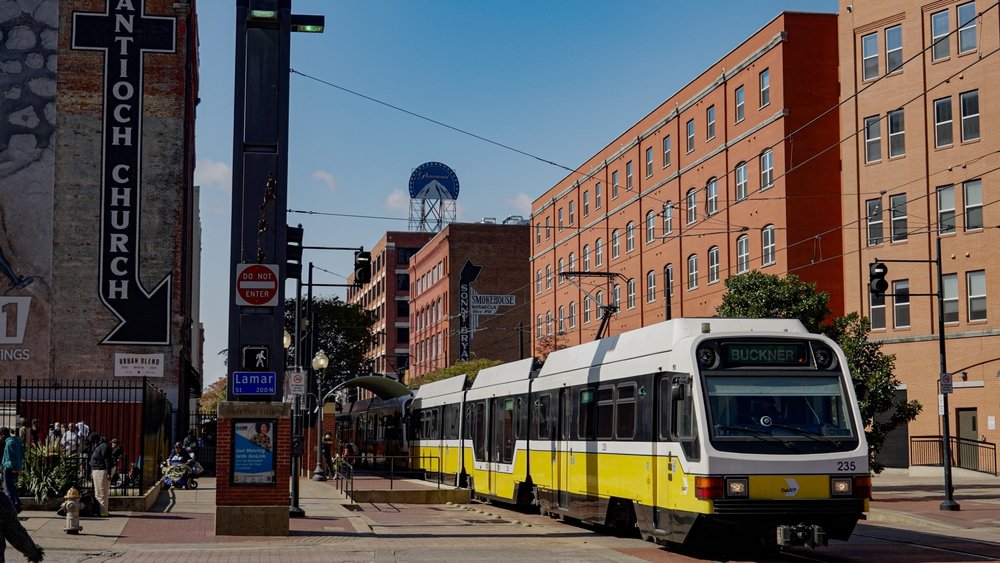
A DART tram travelling through the city center of Dallas, US. Credit: 4kclips/Shutterstock
DART serves 65 stations in nine cities, featuring four lines: the Red, Blue, Green, and Orange lines – with all lines passing through the downtown area of Dallas.
The initial plan for the DART tram network started as a heavy rail project, however after years of financial issues and delays the DART system was established in the early 1990s.
The trams seen on the street of Dallas today follow a blue, white and yellow coloured livery.
8. Budapest, Hungary: 174km
The Budapest tram network boasts a 174 km track, featuring 38 lines and 630 stops, with 320 trams in service.
The network, operated by Budapesti Közlekedési Központ (BKK), acts as the city's public transport backbone, complementing the 1400km overall transport links in Budapest.
The trams seen across the city have always remained a popular form of transport by the Hungarian public, with over 1,000 trams being run during WW1.
Horse-drawn trams first appeared in Budapest in 1866, on Kálvin tér, in the Pest side of the city and it was not until 20 years later that the first electric tram entered service.
The building work began in October 1887 with the assistance of Siemens & Halke, who also built the world's first public tramway six years earlier in Berlin.

A tram passing through the historic city centre of Budapest, Hungary. Credit: Winds/Shutterstock
According to Hungary Today, despite the trams originally being limited to a speed of 10km/h, the first tram accident occurred just 3 days after their introduction, on 1 December 1887.
Today, you'll find the iconic yellow trams spread across the streets of Budapest. Hungarian art historian Károly Lyka wrote about the new yellow trams in 1911, emphasizing how 'fresh and bright' the boulevard looked after the yellow trams were introduced. He also called the old brown carriages “dull” and “inexpressive.”
The BKK says that the Budapest tram network is accessed by 930,000 passengers per day, with Line 4 and Line 6 having one of the highest frequencies across the whole of Europe.
7. Vienna, Austria: 176.9km
The Vienna tram network has 29 lines and 1,071 stations forming a rail network of 176.9km. With operations initially starting in 1865, the Vienna tram network now transports 293.6 million passengers per year making it a vital transport link for the city.
According to Vienna Direct, residents of Vienna call their trams "bims" colloquially, a contraction of the word "bimmeln", which comes from the ringing of the bell when the tram moves off.
Operated today by Wiener Linien the trams seen on the streets of the Austrian capital resemble the white and red colours of the flag, with the most popular route circling the Vienna ring road, or Ringstraße.

A tram on the famous Ringstrasse passing the historic Burgtheater (Imperial Court Theatre). Credit: canadastock/Shutterstock
The Vienna trams have a unique style of operation, in that they run at higher speeds in the morning and night than they do during the day; they run at speeds of 15.1 km/h in the morning, 14.8km/h during the day, and 16.4km/h at night.
The tram network in Vienna began in 1840 with a horse-drawn tram, but the concept was abandoned and not revived until 1865. According to a Vienna tourist website, labour conditions were dreadful during the inaugural tram operations, with employees working up to 19 hours a day.
6. Katowice (upper Silesia), Poland: 178km
The Upper-Silesian Katowice tram network, which currently spans 178km, is the largest tram network in Poland. With operations starting in 1894, the Katowice tram network features 677 stops across 29 lines.
The tram routes traverse a region that was historically dominated by coal mining and steel manufacture, with its mix of major and smaller towns and communities, as well as rural regions.
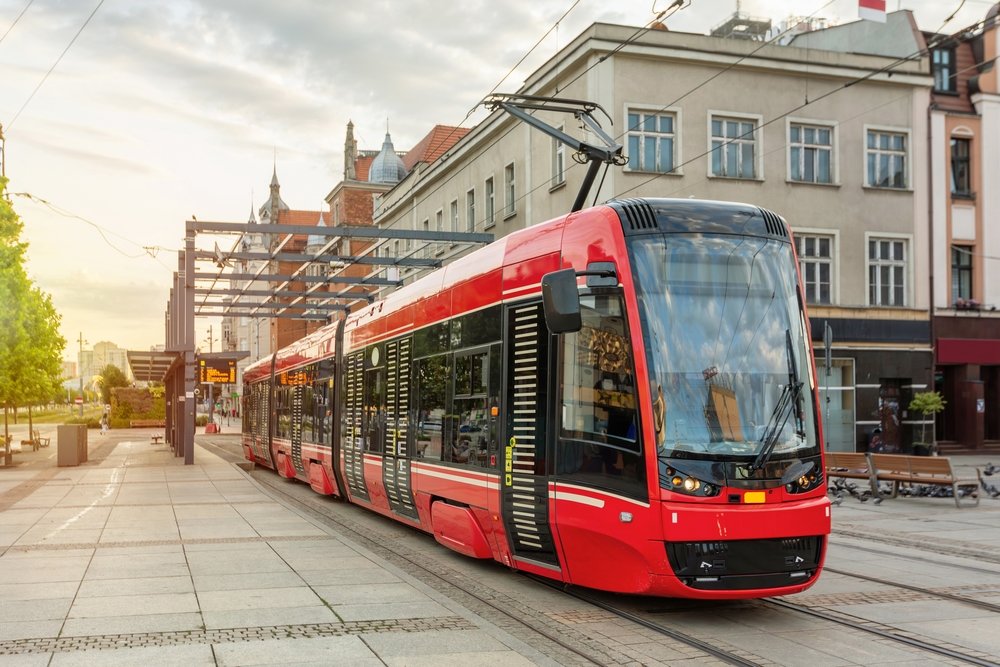
One of the new trams in the center of Katowice, Poland. Credit: Sergey Dzyuba/Shutterstock
Many of the trams seen on the streets of Katowice today are vivid blue and yellow in colour, comparable to the city's flag, and are operated by the ZTM company.
According to ZTM, every day, 1700 buses, trams, and trolleybuses with the ZTM emblem operate across Silesia and Zagbie.
Furthermore, Katowice is a member of The Metropolitan Association of Upper Silesia and the Dbrowa Basin, often known as the Silesian Metropolis, together with 40 other adjacent cities and municipalities.
5. Milan, Italy: 181.8 km
The Milan tram network features a track of 181.8km, comprising 17 urban lines that run daily until midnight. The tram network in Milan, operated by Azienda Trasporti Milanesi, is the longest across Italy.
The history of the Milanese trams started, like with many other cities, as a horse-powered system in 1876.
However, according to Milan Public Transport, the electric tram was introduced in 1901, after a proposal from the Edison Company, which had suggested the project to the municipality of Milan seven years earlier.

A vintage tram in the centre of the Old Town of Milan, Italy. Credit: kavalenkava/Shutterstock
Trams in yellow and cream can be seen on the streets of Milan today, many of which were constructed in the 1930s.
According to Res Humana, the "tram type 1928" tram series is the oldest still in use, with 502 trams manufactured between 1928 and 1932.
4. Moscow, Russia: 182km
Russia's capital is home to a tram network length of 182km containing 40 lines and five depots.
The introduction of tram routes in Moscow started a lot later than other regions, with the opening in March 1899, connecting the Butyrka Gate and Petrovsky Park.
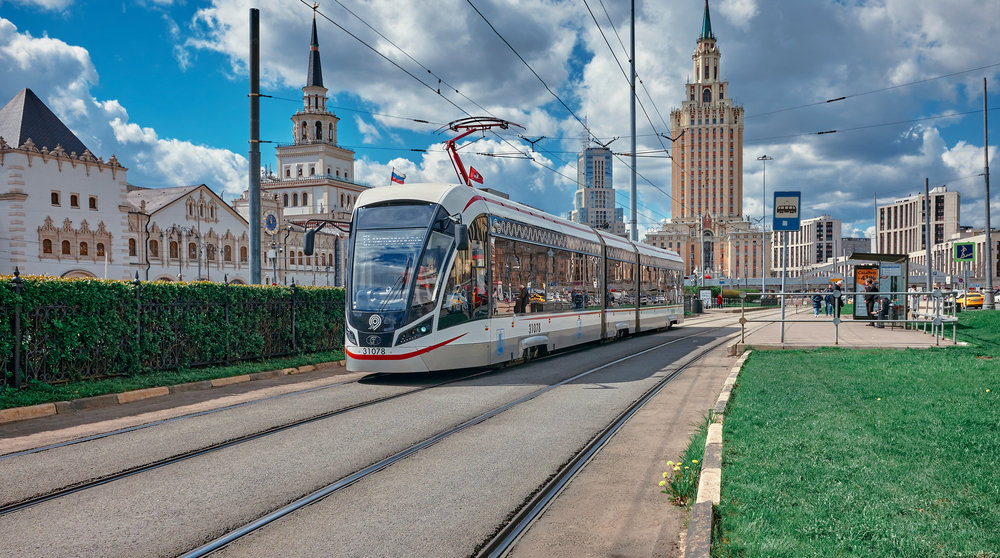
One of the new models of tram on a street of Moscow, Russia. Credit: Aleksei Golovanov/Shutterstock
Many of the trams seen in Moscow today are a vibrant red colour, which resembles the flag of the city.
The tram network, which today carries 214 million passengers per year, is not as active and energetic as it once was in the early 20th century.
3. Berlin, Germany: 193km
Berlin's 193km tram network consists of 22 lines, which operate on a standard gauge network of approximately 800 stations.
The tram network in Berlin dates back to 1865, when the first horse-drawn railway with double-decker carriages, seating 56 people, began operations. The need for rail cars surged as a result of increased migration from the countryside to Berlin during the industrialisation period, which provided many work opportunities.
However, according to Siemens, something was lacking with the "old horse-drawn hackney cabs", leading to the establishment of the first electric streetcar system in the German capital in 1881.
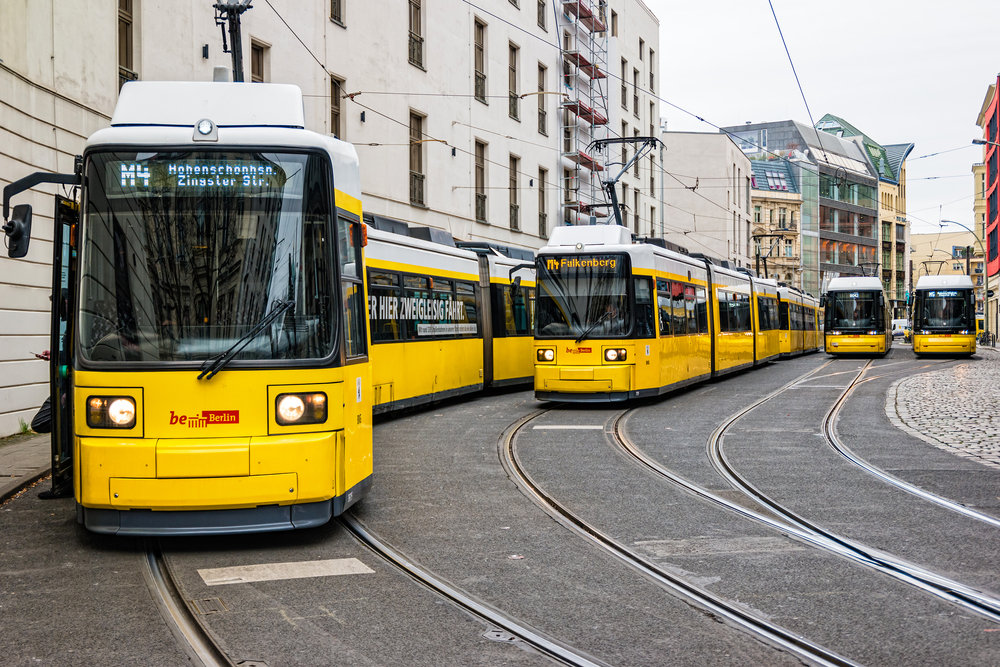
Several yellow trams on a street in the center of Berlin, germany. Credit: Perekotypolev/Shutterstock
Siemens described the initiative as an "immense success," with several locations across Europe following suit and tram networks expanding into international cities.
Operated by Berliner Verkehrsbetriebe (BVG), seen on the streets of Berlin today are the classic yellow BVG trams, which as previously reported by Railway Technology, feature many of the Bombardier FLEXITY trams.
According to BVG, "the mobility of the future in Berlin is yellow," and they are currently partnering with the German Government to establish a transportation network that fits with climate protection goals and provides a "livable metropolis" for all.
The BVG tram network is made up of nine Metrotram lines (M1 to M17) and thirteen traditional tram lines (12 to 68).
2. St. Petersburg, Russia: 205.5km
St Petersburg's tram network currently covers 205.5km and spans 40 routes, forming the largest tram network in Europe.
The St. Petersburg tram network boasts a history quite different to other regions, which includes 'ice trams' and a former extended network making it the largest in the world.
The city of St. Petersburg saw the introduction of horse-drawn trams in 1863. The first electric tram was tested and developed in St. Petersburg in January 1880 by Russian engineer Fyodor Pirotsky, but the cost of converting the existing horseway to electric trams was deemed too high, resulting in a 27-year delay in the development of electric transport in the city.

A tram passing the front of Vitebsk Railway Station in St. Petersburg, Russia. Credit: Olga Visavi/Getty Images
An ice tram was introduced in St Petersburg, across the frozen Neva River, which was deemed incredibly popular, serving nearly a million passengers each season.
The tram network in St. Petersburg once spanned a total length of over 700km. By 1990 the city had 2,200 tram cars and carried 950 million passengers.
The trams seen across the streets in St Petersburg today feature a red and white colour, resembling the city's flag, and run at frequencies of 10-15 minutes daily.
1. Melbourne, Australia: 250km
The Melbourne tram network, spanning a total length of 250km, accounts for a little over a quarter of the entire length of tram infrastructure in the Asia-Pacific region.
The double-track network features 520 trams with 1,700 tram stops, including 450 accessible stops and 23 routes, as well as the city circle.
The Melbourne Tramway and Omnibus Company constructed the first cable line in 1885, launching Melbourne's tram system. According to Yarra Trams, Melbourne's tram operator, the city's first electric tram service began between Box Hill and Doncaster on 14 October 1889.

The Melbourne tram network is the largest in operation in the world – for now. Credit: GagliardiPhotography/Shutterstock
Non-electric tram operations in Melbourne, on the other hand, began considerably earlier due to the region's difficulties in moving bulky cargo, resulting in cable trams spreading throughout the industry in 1873.
Yarra Trams says that the trams in Melbourne today run 5,000+ services daily, which equates to over 200 million trips completed annually.
The Melbourne trams seen on the street today feature the classic green and yellow livery selected by the Metropolitan Transit Authority (MTA).